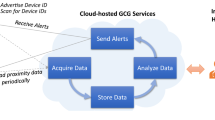Abstract
The contact tracing system implemented in Indonesia is called SILACAK, a modified version of DHIS2. SILACAK as a contact tracing system platform created a dashboard following national guidelines, which is a tool to monitor the COVID-19 cases in Indonesia and support decision making. The role of SILACAK has throughout several journeys and some changes that can be implemented by several actors involved such as the developer team, government, health workers, and also society. To analyze the connection between all aspects that affect the SILACAK system, A framework is needed to deeply review which can be a historical artifact on the system. Actor- network theory (ANT) is the best practice to know about how networks come into being, to trace what associations exist, how they move, how actors are enrolled into a network, how parts of a network form a whole network and how networks achieve temporary stability.
Access this chapter
Tax calculation will be finalised at checkout
Purchases are for personal use only
Similar content being viewed by others
References
Martin, A., Markhvida, M., Hallegatte, S., Walsh, B.: Socio-economic impacts of covid-19 on household consumption and poverty. Econ. Disasters Clim. Change 4(3), 453–479 (2020). https://doi.org/10.1007/s41885-020-00070-3
Shadmi, E., Chen, Y., Dourado, I., Faran-Perach, I., Furler, J., Hangoma, P.: Health equity and COVID-19: global perspectives. Int. J. Equity Health 19, 104 (2020). https://doi.org/10.1186/s12939-020-01218-z
Gorbiano, M.I.: BREAKING: Jokowi announces Indonesia’s first two confirmed COVID-19 cases. The Jakarta Post (2020)
Hsieh, L., Child, J.: What coronavirus success of Taiwan and Iceland has in common. The Conversation 29 (2020)
Permatasari, D.: Kebijakan Covid-19 dari PSBB hingga PPKM Empat Level. Kompaspedia (2021)
Taufiq, R.I.: Effectiveness of ppkm (enforcement of restrictions on community activities) emergency and levels 1–4 on control of spread covid 19 virus in east java. Percipience J. Soc., Adm., Entrepreneurship J. 1(1) (2021)
Permenkes RI. No HK.01.07/MENKES/4641/2021 tentang Panduan Pelaksanaan Pemeriksaan, Pelacakan, Karantina, dan Isolasi dalam Rangka Percepatan Pencegahan dan Pengendalian Coronavirus Disease 2019 (Covid-19). Jakarta: Menteri Kesehatan Republik Indonesia, No HK.01.07/MENKES/4641/2021 Jakarta: Menteri Kesehatan Republik Indonesia (2021)
Syefira, S., Sitompul, T.H., Lian, L., Dewi, E., Meilani, P., Braa, J.: DHIS2 Contact Tracing Application (SILACAK) Tracer Self-Registration System: Pro-active solution using Whatsapp-BOT (AMICA). Dhis2community (2021)
Mgudlwa, S., Iyamu, T.: A Framework for accessing patient big data: ANT view of a south African health facility. The Afr. J. Inform. Syst. 13(2), 65–81 (2021)
Manya, A., Braa, J., Sahay, S.: A socio-technical approach to understanding data quality in health information systems: Data quality intervention in Kenya. In: 2015 IST-Africa Conference, IST-Africa (2015). https://doi.org/10.1109/ISTAFRICA.2015.7190582
Kimaro, H., Nyella, E.: HIS Standardization in developing countries: use of boundary objects to enable multiple translations. The Afr. J. Inform. Syst. 8(1), 72 (2015)
Myers, M.D.: Qualitative research in information systems. MIS Q. 21(2), 241 (1997). https://doi.org/10.2307/249422
Mörtl, K., Gelo, O.C.G.: Qualitative methods in psychotherapy process research. In: Gelo, O.C.G., Pritz, A., Rieken, B. (eds.) Psychotherapy Research, pp. 381–428. Springer, Vienna (2015). https://doi.org/10.1007/978-3-7091-1382-0_20
Teles, A., Joia, L.A.: Assessment of digital inclusion via the actor-network theory: the case of the Brazilian municipality of Piraí. Telematics Inform. 28(3), 191–203 (2011). https://doi.org/10.1016/j.tele.2010.09.003
Callon, M.: Some elements of a sociology of translation: domestication of the scallops and the fishermen of St Brieuc Bay. The Soc. Rev. 32(1_suppl), 196–233 (2015). https://doi.org/10.1111/j.1467-954X.1984.tb00113.x
Heeks, R., Stanforth, C.: Technological change in developing countries: opening the black box of process using actor–network theory. Dev. Stud. Res. 2(1), 33–50 (2015). https://doi.org/10.1080/21665095.2015.1026610
Sitompul, T., Senyoni, W., Braa, J., Yudianto: Convergence of technical and policy processes: a study of indonesia’s health information systems. In: IFIP Advances in Information and Communication Technology (2019). https://doi.org/10.1007/978-3-030-18400-1_32
Costa, C.C., da Cunha, P.R.: Business model design from an ANT perspective: contributions and insights of an open and living theory. In: Nelson, M.L., Shaw, M.J., Strader, T.J. (eds.) AMCIS 2009. LNBIP, vol. 36, pp. 56–67. Springer, Heidelberg (2009). https://doi.org/10.1007/978-3-642-03132-8_5
Sarker, S., Sarker, S., Sidorova, A.: Understanding business process change failure: an actor-network perspective. J. Manag. Inform. Syst. 23(1), 51–86 (2006). https://doi.org/10.2753/MIS0742-1222230102
Bueger, C., Stockbruegger, J.: Actor-network theory. In: McCarthy, D.R. (ed.) Technology and World Politics: An Introduction, pp. 42–59. Routledge (2017). https://doi.org/10.4324/9781317353836-3
Latour, B.: Reassembling the social: an introduction to actor-network theory. Oup Oxford, p. 43 (2007)
Afarikumah, E.: Deploying actor -network theory to analyse telemedicine implementation in Ghana. Sci. J. Publ. Health 1(2), 77 (2013). https://doi.org/10.11648/j.sjph.20130102.15
Arnaboldi, M., Spiller, N.: Actor-network theory and stakeholder collaboration: the case of Cultural Districts. Tourism Manag. 32(3), 641–654 (2011). https://doi.org/10.1016/j.tourman.2010.05.016
Braa, J., Sahay, S., Lewis, J., Senyoni, W.: Health information systems in Indonesia: understanding and addressing complexity. In: Choudrie, J., Islam, M.S., Wahid, F., Bass, J.M., Priyatma, J.E. (eds.) ICT4D 2017. IAICT, vol. 504, pp. 59–70. Springer, Cham (2017). https://doi.org/10.1007/978-3-319-59111-7_6
Vesterinen, H.M., et al.: Strengthening multi-sectoral collaboration on critical health issues: one health systems mapping and analysis resource toolkit (OH-SMART) for operationalizing one health. PloS one. 14(7), e0219197 (2019)
Kuruvilla, S., et al.: Business not as usual: how multisectoral collaboration can promote transformative change for health and sustainable development. Bmj 36, 4 (2018). https://doi.org/10.1136/bmj.k4771
Making multiple systems work as one through System Integration [Internet]. [Place Unknow]: Iwconnect; [Updated 2019;Cited 2022 Jun 6] (2019). https://iwconnect.com/making-multiple-systems-work-as-one-through-integr
Author information
Authors and Affiliations
Corresponding author
Editor information
Editors and Affiliations
Rights and permissions
Copyright information
© 2022 IFIP International Federation for Information Processing
About this paper
Cite this paper
Sitompul, T., Meilani, P., Salsabila, S., Fathurrahim, R., Wahono, R., Braa, J.A. (2022). Journey on Flattening the Curve: The Actors and Networks of Indonesian Contact Tracing System. In: Zheng, Y., Abbott, P., Robles-Flores, J.A. (eds) Freedom and Social Inclusion in a Connected World. ICT4D 2022. IFIP Advances in Information and Communication Technology, vol 657. Springer, Cham. https://doi.org/10.1007/978-3-031-19429-0_9
Download citation
DOI: https://doi.org/10.1007/978-3-031-19429-0_9
Published:
Publisher Name: Springer, Cham
Print ISBN: 978-3-031-19428-3
Online ISBN: 978-3-031-19429-0
eBook Packages: Computer ScienceComputer Science (R0)





